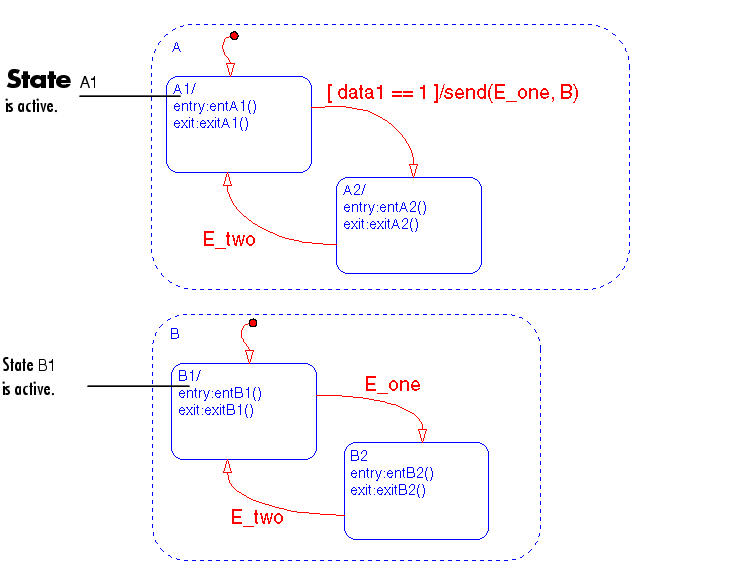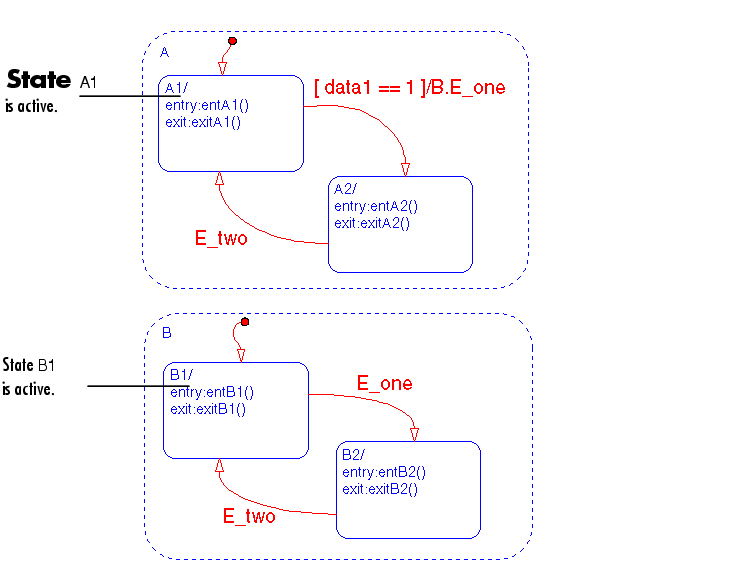

| Stateflow |   |
Example: Directed Event Broadcast Using send
This example shows the semantics of directed event broadcast using send(event_name,state_name) in a transition action.

Initially the Stateflow diagram is asleep. Parallel substates A.A1 and B.B1 are active. By definition, this implies parallel (AND) superstates A and B are active. An event occurs and awakens the Stateflow diagram. The condition [data1==1] is true. The event is processed from the root of the Stateflow diagram down through the hierarchy of the Stateflow diagram:
A checks for any valid transitions as a result of the event. Since the condition [data1==1] is true, there is a valid transition from state A.A1 to state A.A2.
A.A1 exit actions execute and complete (exitA1()).
Start of E_one Event Processing
A.A1 is marked inactive.
send(E_one,B) is executed and completed.
E_one awakens state B. (This is a nested event
broadcast.) Since state B is active, the directed broadcast is received and
state B checks to see if there is a valid transition. There is a valid
transition from B.B1 to B.B2.
B.B1 executes and completes exit actions (exitB1()).
B.B1 is marked inactive.
B.B2 is marked active.
B.B2 executes and completes entry actions (entB2()).
End of Event E_one Processing
This sequence completes the execution of this Stateflow diagram associated with an event broadcast and the directed event broadcast to a parallel state of event E_one.
Example: Directed Event Broadcasting Using Qualified Event Names
This example shows the semantics of directed event broadcast using a qualified event name in a transition action.

Initially the Stateflow diagram is asleep. Parallel substates A.A1 and B.B1 are active. By definition, this implies parallel (AND) superstates A and B are active. An event occurs and awakens the Stateflow diagram. The condition [data1==1] is true. The event is processed from the root of the Stateflow diagram down through the hierarchy of the Stateflow diagram:
A checks for any valid transitions as a result of the event. Since the condition [data1==1] is true, there is a valid transition from state A.A1 to state A.A2.
A.A1 exit actions execute and complete (exitA1()).
A.A1 is marked inactive.
E_one to state B (represented by the notation B.E_one), is executed and completed.
E_one awakens state B. (This is a nested event
broadcast.) Since state B is active, the directed broadcast is received and
state B checks to see if there is a valid transition. There is a valid
transition from B.B1 to B.B2.
B.B1 executes and completes exit actions (exitB1()).
B.B1 is marked inactive.
B.B2 is marked active.
B.B2 executes and completes entry actions (entB2()).
A.A2 is marked active.
A.A2 entry actions execute and complete (entA2()).
This sequence completes the execution of this Stateflow diagram associated with an event broadcast using a qualified event name to a parallel state.
 | Parallel (AND) States | Execution Order |  |